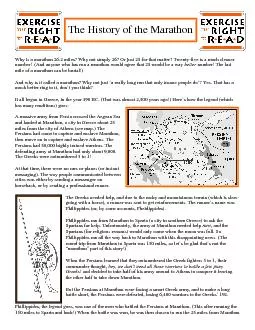/


to Athens to relay the news of the victory He made it but was so exhausted from running to Sparta and back battling the Persians and then racing to Athens that he collapsed after shouting ID: 119262
Download Pdf The PPT/PDF document "The History of the Marathon Why is a mar..." is the property of its rightful owner. Permission is granted to download and print the materials on this web site for personal, non-commercial use only, and to display it on your personal computer provided you do not modify the materials and that you retain all copyright notices contained in the materials. By downloading content from our website, you accept the terms of this agreement.
The History of the Marathon Why is a marathon 26.2 miles? Why not simply 26? Or just 25 for that matter? Twenty-five is a much cleaner number! (And anyone who has run a marathon would agree that 25 would be a way better number! The last mile of a marathon can be brutal!) And why is it called a marathon? Why not just a really long run that only insane people do? Yes. That has a much better ring to it, dont you think? It all began in Greece, in the year 490 BC. (That was almost 2,500 years ago!) Heres how the legend (which has many renditions) goes: A massive army from Persia crossed the Aegean Sea and landed at Marathon, a city in Greece about 25 miles from the city of Athens (see map.) The Persians had come to capture and enslave Marathon, then move on to capture and enslave Athens. The Persians had 50,000 highly trained warriors. The defending army at Marathon had only about 9,000. The Greeks were outnumbered 5 to 1! At that time, there were no cars or planes (or instant messaging). The way people communicated between cities was either by sending a messenger on horseback, or by sending a professional runner. The Greeks needed help, and due to the rocky and mountainous terrain (which is slow-going with a horse), a runner was sent to get reinforcements. The runners name was Phillippides (or, by some accounts, Pheidippides). Phillippides ran from Marathon to Sparta (a city in southern Greece) to ask the Spartans for help. Unfortunately, the army at Marathon needed help now, and the Spartans (for religious reasons) would only come when the moon was full. So Phillippides ran all the way back to Marathon with this disappointing news. (The round trip from Marathon to Sparta was 150 miles, so lets be glad thats not the marathon part of this story!) When the Persians learned that they outnumbered the Greek fighters 5 to 1, their commander thought, hey, we dont need all these warriors to battle a few puny Greeks! and decided to take half of his army around to Athens to conquer it leaving the other half to take down Marathon. But the Persians at Marathon were facing a smart Greek army, and to make a long battle short, the Persians were defeated, losing 6,400 warriors to the Greeks 192.Phillippides, the legend goes, was one of the men who battled the Persians at Marathon. (This after running the 150 miles to Sparta and back!) When the battle was won, he was then chosen to run the 25 miles from Marathon to Athens to relay the news of the victory. He made it, but was so exhausted (from running to Sparta and back, battling the Persians, and then racing to Athens) that he collapsed after shouting Rejoice, we conquer! and then died. He lives on, though, in the heart of runners as a symbol of commitment, endurance, and willpower. According to military historian Edward S. Creasy, author of Fifteen Decisive Battles of the World, The day of Marathon is the critical epoch in the history of the two nations. It broke forever the spell of Persian invincibility, which had previously paralyzed men's minds It secured for mankind the intellectual treasures of Athens, the growth of free institutions, the liberal enlightenment of the Western world, and the gradual ascendancy for many ages of the great principles of European Civilization." In other words, it changed history. But still, if the distance from Marathon to Athens was about 25 miles, why is the marathon 26.2 miles? Fast forward to 1896, when the modern Olympic Games were inaugurated in Greece. As part of Greek heritage, the legend of Phillippides was revived by a 24.85 mile (40,000 meters) run from Marathon Bridge to Olympic stadium in Athens. Okay .but, that still doesnt tell us why a marathon is 26.2 miles, does it? So fast forward again to the1908 Olympic Games which were held in London, England. Youre not going to believe this, but because the royal family wanted the marathons finish line to be in front of the royal familys viewing box, the course was lengthened to 26.2 miles. (The king and queen wanted the end of the race to come to them, and so the runners had to go even farther!) Anyway, after 16 years of extremely heated discussion, this 26.2 mile distance was established at the 1924 Olympics in Paris, France as the official marathon distance. And that is why the marathon is called the marathon, and why it is 26.2 miles in length. A Couple More Interesting Tidbits Marathon is a Greek work meaning fennel (fennel seeds are used as flavoring in foods), and the city of Marathon is a place that had fields of fennel plants. 26.2 miles is equal to 26 miles plus 385 yards, or 42.16 kilometers. Its also, by the foot, equivalent to a long, long way.